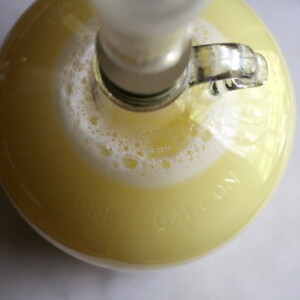Pineapple Wine
Pineapple wine is an easy-to-make homemade fruit wine with amazing tropical flavor.
Servings: 20 glasses (1 gallon, about 4 bottles)
Ingredients
- 3 to 4 lbs pineapple 7 to 10 cups, chopped *See Note if using juice
- 2 lbs sugar or 2 lbs honey for pineapple mead
- 1/2 tsp. Acid Blend
- 1/4 tsp. tannin powder
- 1 tsp. Yeast Nutrient
- 1/2 tsp. Pectic Enzyme optional, but recommended
- 1 Campden tablet crushed (optional)
- 1 wine yeast
Instructions
- Peel and chop pineapple and place it in a nylon fermentation bag inside a bucket fermenter (at least 2 gallons in size).
- Bring 3 quarts water and sugar to a boil on the stove, stir to dissolve, and then remove from heat.
- Allow the sugar water to cool to room temperature, then pour it over the pineapple in the fermenter.
- Add the remaining ingredients (except yeast), including tannin, acid, yeast nutrient, and crushed Camden tablet (if using). Stir to incorporate.
- Allow the mixture to sit covered with a towel for 24 hours to allow the Camden tablet to work (skip this waiting period if not using Camden tablet).
- After 24 hours, add the yeast and recover with a towel or cover loosely with a lid. The mixture will be vigorously fermenting, so it's not necessary (or recommended) to use a water lock during this stage.
- Allow the mixture to ferment in primary for 7 to 10 days, until the vigorous fermentation slows. Remove the pineapple and siphon into a secondary fermenter, filling to within a few inches of the top with unchlorinated water. (A one-gallon narrow neck glass carboy is recommended.) Cap with a water lock and allow the mixture to ferment for 6 to 8 weeks.
- At this point, the wine could be bottled, but it's highly recommended to rack several more times to help mature and clarify the wine. I'd suggest racking every 2 months for a total of 6 months (after the primary) before bottling.
- At bottling time, you can choose to bottle the wine as it is (as I did), or stabilize the wine and back sweeten with 2 to 6 ounces of sugar dissolved in water. Taste the wine before you bottle and make the decision based on your palate (adding sugar for a sweeter wine).
- Allow the wine to bottle condition for at least 2 months before drinking (preferably longer).
Notes
Pineapple Juice (instead of Fruit) - For a pineapple wine made with juice, substitute 2 quarts of pineapple juice in place of the fresh pineapple (and fill with water).
Nutrition
Calories: 209kcal | Carbohydrates: 54g | Protein: 0.4g | Fat: 0.2g | Saturated Fat: 0.01g | Polyunsaturated Fat: 0.03g | Monounsaturated Fat: 0.01g | Sodium: 1mg | Potassium: 75mg | Fiber: 1g | Sugar: 52g | Vitamin A: 39IU | Vitamin C: 33mg | Calcium: 9mg | Iron: 0.2mg
